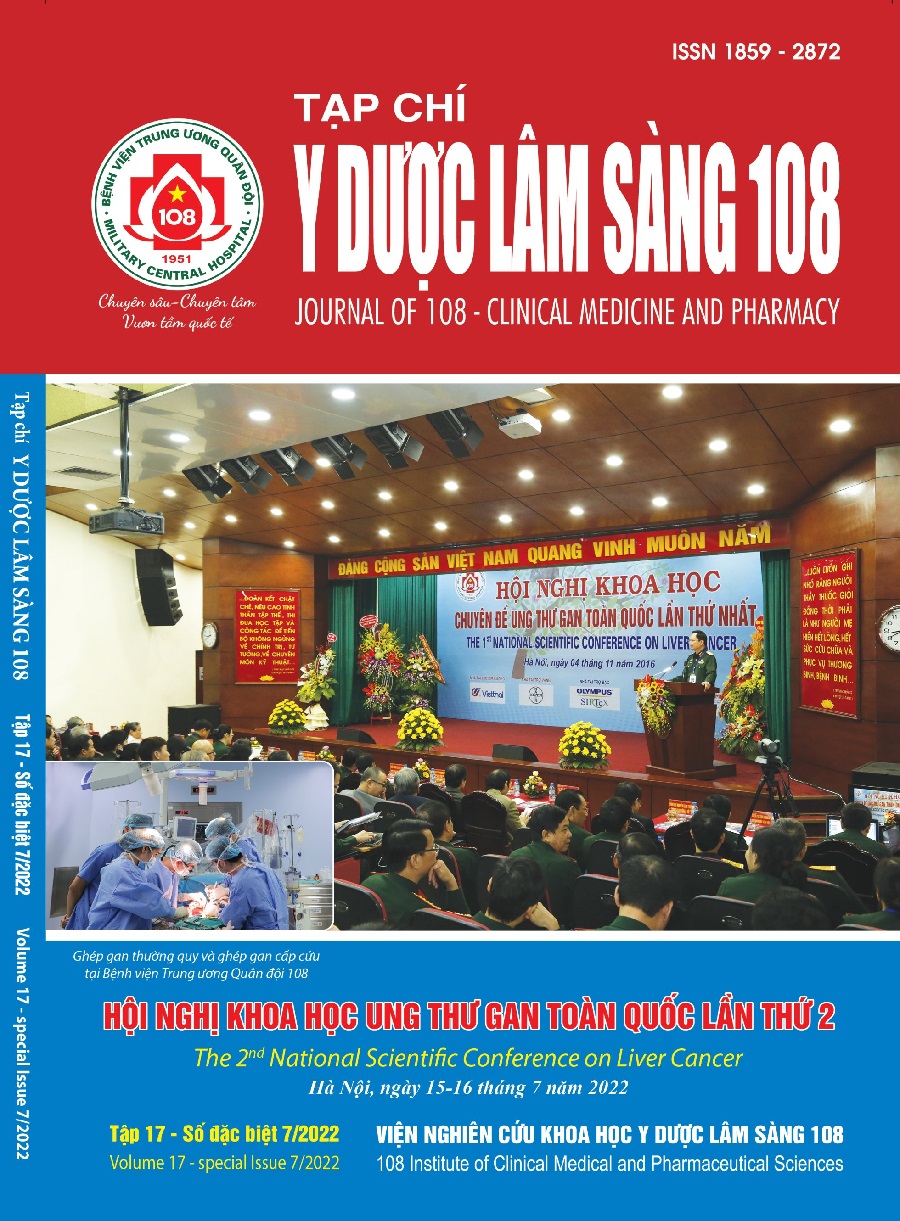The serum concentration of high sensitivity-C reactive protein in patients with hepatocellular carcinoma
Main Article Content
Keywords
Abstract
Objective: To investigate serum hs-CRP concentration and its relationship with some tumor characteristics and stages in patients with HCC. Subject and method: A cross-sectional study was conducted on 76 HCC patients and 38 healthy adults. The serum hs-CRP levels were measured by means of immunonephelometric assay (Beckman AU-2700, USA) at Department of Biochemistry, 108 Military Central Hospital. Result: Median serum hs-CRP concentration in HCC group was 3.33mg/l, significant higher than that in control group (0.62mg/l), p<0.05. There was a difference of hs-CRP concentration between HCC patients who had portal vein thrombus (PVT) and HCC patients without PVT (15.37mg/l vs. 0.62mg/l, p<0.05), between diffuse HCCs and nodular HCCs. There was a linear correlation between serum hs-CRP concentration and tumour size. Diagnostic values of serum hs-CRP for HCC with AFP < 20ng/ml, at the cut off point 1.08mg/l, were: the sensitivity 84.6%, the specifity 76.3% and an AUC of 0.837. Conclusion: Serum hs-CRP is a potential biomarker in diagnosis and prognosis of HCC.
Article Details
References
2. Balkwill F and Mantovani A (2001) Inflammation and cancer: Back to Virchow?. Lancet 357(9255): 539-545.
3. Singh AK, Kumar R, Pandey AK (2018) Hepatocellular carcinoma: Causes, mechanism of progression and biomarkers. Curr Chem Genom Transl Med 12: 9-26.
4. Black S, Kushner I, and Samols D (2004) C-reactive protein. J Biol Chem 279(47): 48487-48490.
5. Wang CS, Sun CF (2009) C-reactive protein and malignancy: Clinico-pathological association and therapeutic implication. Chang Gung Med J 32(5): 471-482.
6. Heikkila K, Ebrahim S, and Lawlor DA (2007) A systematic review of the association between circulating concentrations of C reactive protein and cancer. J Epidemiol Community Health 61(9): 824-833.
7. Ko YJ, Kwon YM et al (2012) High-sensitivity c-reactive protein levels and cancer mortality. 21(11): 2076-2086.
8. Zheng Z, Zhou L et al (2013) Prognostic role of C-reactive protein in hepatocellular carcinoma: A systematic review and meta-analysis. Int J Med Sci 10(6): 653-664.
9. Lee S, Choe JW et al (2011) High-sensitivity C-reactive protein and cancer. J Epidemiol 21(3): 161-168.
10. Ma LN, Liu XY et al (2017) Assessment of high-sensitivity C-reactive protein tests for the diagnosis of hepatocellular carcinoma in patients with hepatitis B-associated liver cirrhosis. Oncol Lett 13(5): 3457-3464.
11. Ram AK, Pottakat B and Vairappan B (2018) Increased systemic zonula occludens 1 associated with inflammation and independent biomarker in patients with hepatocellular carcinoma. BMC Cancer 18(1): 572.
12. Carr BI, Akkiz H et al (2018) C-reactive protein and hepatocellular carcinoma: Analysis of its relationships to tumor factors. Clin Pract (Lond). 15(Spec Issue): 625-634.
13. Asli Suner, Brian I Carr, Hikmet Akkiz et al (2019) Imflamatory markers C-reactive protein and PLR in relation to HCC characteristics. J Transl Sci 5(3): 10.15761/JTS.1000260.
14. Dương Quang Huy and Vũ Minh Thắng (2017) Nghiên cứu sự biến đổi nồng độ Interleukin huyết thanh ở bệnh nhân ung thư biểu mô tế bào gan. Tạp chí Y - Dược học Quân sự (7).
 ISSN: 1859 - 2872
ISSN: 1859 - 2872
